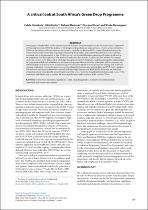JavaScript is disabled for your browser. Some features of this site may not work without it.
- ResearchSpace
- →
- Research Publications/Outputs
- →
- Journal Articles
- →
- View Item
| dc.contributor.author |
Ntombela, Cebile

|
|
| dc.contributor.author |
Funke, Nicola S

|
|
| dc.contributor.author |
Meissner, Richard

|
|
| dc.contributor.author |
Steyn, Maronel

|
|
| dc.contributor.author |
Masangane, Winile

|
|
| dc.date.accessioned | 2017-05-16T09:36:28Z | |
| dc.date.available | 2017-05-16T09:36:28Z | |
| dc.date.issued | 2016-10 | |
| dc.identifier.citation | Ntombela, C., Funke, N.S., Meissner, R., et al. 2016. A critical look at South Africa’s Green Drop Programme. Water SA, vol. 42(4): 703-709 | en_US |
| dc.identifier.issn | 0378-4738 | |
| dc.identifier.uri | http://dx.doi.org/10.4314/wsa.v42i4.21 | |
| dc.identifier.uri | http://www.wrc.org.za/Knowledge%20Hub%20Documents/Water%20SA%20Journals/Manuscripts/2016/04%20October%202016/3286.pdf | |
| dc.identifier.uri | http://hdl.handle.net/10204/9032 | |
| dc.description | Copyright: WRC 2016. Published under a Creative Commons Attribution Licence | en_US |
| dc.description.abstract | In this paper we briefly reflect on the different legislation and types of regulatory mechanisms that South Africa’s Department of Water and Sanitation (DWS) has in place to try to improve the performance and compliance of water services authorities (WSAs) in the controversial wastewater services sector. In particular, we focus on DWS’s incentive-based mechanism, the National Green Drop Certification Programme (Green Drop Programme), and evaluate the achievements and challenges associated with its implementation to date. While there has been considerable improvement in performance in all areas of the programme since its inception in 2009, much still needs to be done in order to address the dire situation the country’s wastewater services sector finds itself in. Challenges facing the Green Drop Programme and the municipalities implementing the programme include: lack of human resource capacity to prepare effective corrective action plans and/or wastewater risk abatement plans; lack of finances for mainstreaming of wastewater treatment in municipal decision-making; lack of forward planning; problematic bureaucratic processes; complex relationship between some municipalities and DWS; theft, vandalism and misuse of wastewater treatment infrastructure and not enough transparency. Based on this discussion, we make some concluding remarks about possible areas of improvement that could potentially strengthen the functioning and success of this programme, and thereby help to improve the levels of performance and compliance of the country’s WSAs. | en_US |
| dc.language.iso | en | en_US |
| dc.publisher | Water Research Commission | en_US |
| dc.rights | CC0 1.0 Universal | * |
| dc.rights.uri | http://creativecommons.org/publicdomain/zero/1.0/ | * |
| dc.subject | Wastewater treatment | en_US |
| dc.subject | Green Drop Programme | en_US |
| dc.subject | Incentive-based mechanism | en_US |
| dc.subject | Command-and-control mechanism | en_US |
| dc.subject | Water services authorities | en_US |
| dc.title | Critical look at South Africa’s Green Drop Programme | en_US |
| dc.type | Article | en_US |
| dc.identifier.apacitation | Ntombela, C., Funke, N. S., Meissner, R., Steyn, M., & Masangane, W. (2016). Critical look at South Africa’s Green Drop Programme. http://hdl.handle.net/10204/9032 | en_ZA |
| dc.identifier.chicagocitation | Ntombela, Cebile, Nicola S Funke, Richard Meissner, Maronel Steyn, and Winile Masangane "Critical look at South Africa’s Green Drop Programme." (2016) http://hdl.handle.net/10204/9032 | en_ZA |
| dc.identifier.vancouvercitation | Ntombela C, Funke NS, Meissner R, Steyn M, Masangane W. Critical look at South Africa’s Green Drop Programme. 2016; http://hdl.handle.net/10204/9032. | en_ZA |
| dc.identifier.ris | TY - Article AU - Ntombela, Cebile AU - Funke, Nicola S AU - Meissner, Richard AU - Steyn, Maronel AU - Masangane, Winile AB - In this paper we briefly reflect on the different legislation and types of regulatory mechanisms that South Africa’s Department of Water and Sanitation (DWS) has in place to try to improve the performance and compliance of water services authorities (WSAs) in the controversial wastewater services sector. In particular, we focus on DWS’s incentive-based mechanism, the National Green Drop Certification Programme (Green Drop Programme), and evaluate the achievements and challenges associated with its implementation to date. While there has been considerable improvement in performance in all areas of the programme since its inception in 2009, much still needs to be done in order to address the dire situation the country’s wastewater services sector finds itself in. Challenges facing the Green Drop Programme and the municipalities implementing the programme include: lack of human resource capacity to prepare effective corrective action plans and/or wastewater risk abatement plans; lack of finances for mainstreaming of wastewater treatment in municipal decision-making; lack of forward planning; problematic bureaucratic processes; complex relationship between some municipalities and DWS; theft, vandalism and misuse of wastewater treatment infrastructure and not enough transparency. Based on this discussion, we make some concluding remarks about possible areas of improvement that could potentially strengthen the functioning and success of this programme, and thereby help to improve the levels of performance and compliance of the country’s WSAs. DA - 2016-10 DB - ResearchSpace DO - 10.4314/wsa.v42i4.21 DP - CSIR KW - Wastewater treatment KW - Green Drop Programme KW - Incentive-based mechanism KW - Command-and-control mechanism KW - Water services authorities LK - https://researchspace.csir.co.za PY - 2016 SM - 0378-4738 T1 - Critical look at South Africa’s Green Drop Programme TI - Critical look at South Africa’s Green Drop Programme UR - http://hdl.handle.net/10204/9032 ER - | en_ZA |
Files in this item
The following license files are associated with this item:







